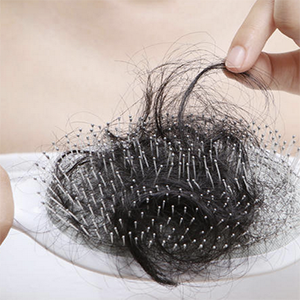Sensitive scalp: an epidemiologic study in patients with hair loss

HTML: 14
All claims expressed in this article are solely those of the authors and do not necessarily represent those of their affiliated organizations, or those of the publisher, the editors and the reviewers. Any product that may be evaluated in this article or claim that may be made by its manufacturer is not guaranteed or endorsed by the publisher.
Sensitive scalp is a common condition defined by the presence of erythema and/or subjective symptoms as pain, pricking, burning, pruritus of the scalp elicited by triggering factors. Trichodynia is a term that describes a sensation of pain or burning of the scalp and was assumed to be part of sensitive scalp. Main goal of the study was to establish the prevalence of sensitive scalp in patients with trichological disorders. We conducted a retrospective observational study recorded: age, sex, trichological disorder (telogen effluvium, androgenetic alopecia, alopecia areata, scarring alopecia, trichotillomania) and scalp symptoms (pruritus, pain, burning and itching sensation). We studied 317 patients of whom 102 patients (32%) complained of sensitive scalp. Telogen effluvium patients had a significantly higher prevalence of sensitive scalp (p <0.001), pain (p= 0.028), burning sensation (p=0.018), pruritus (p=0.016) and trichodynia (p<0.001) than other patients with alopecias. Likewise, AA patients had a statistically significant higher prevalence of pruritus (p=0.0256) and trichodynia (p=0.0223) than other alopecias patients. Sensitive scalp is a frequent symptom reported by patients with hair loss. Telogen effluvium and alopecia areata seem to be most associated to sensitive scalp.
Misery L, Sibaud V, Ambronati M, et al. Sensitive scalp: does this condition exist? An epidemiological study. Contact Dermatitis 2008;58:234-8. DOI: https://doi.org/10.1111/j.1600-0536.2007.01288.x
Sulzberger MB, Witten VH, Kopf AW. Diffuse alopecia in women. Its unexplained apparent increase in incidence. Arch Dermatol 1960;81:556–60. DOI: https://doi.org/10.1001/archderm.1960.03730040060011
Rebora A, Semino MT, Guarrera M. Trichodynia. Dermatology 1996;192:292-3. DOI: https://doi.org/10.1159/000246391
Rebora A. Telogen effluvium: a comprehensive review. Clin Cosmet Investig Dermatol 2019 21;12:583-90. DOI: https://doi.org/10.2147/CCID.S200471
Guichard A, Ma L, Tan Y, et al. What if scalp flora was involved in sensitive scalp onset? Int J Cosmet Sci. 2016;38:429-30. DOI: https://doi.org/10.1111/ics.12298
Ma L, Guichard A, Cheng Y, et al. Sensitive scalp is associated with excessive sebum and perturbed microbiome. J Cosmet Dermatol 2019;18:922-8. DOI: https://doi.org/10.1111/jocd.12736
Willimann B, Trüeb RM. Hair pain (trichodynia): frequency and relationship to hair loss and patient gender. Dermatology. 2002;205:374-7. DOI: https://doi.org/10.1159/000066437
Misery L, Rahhali N, Ambonati M, et al. Evaluation of sensitive scalp severity and symptomatology by using a new score. J Eur Acad Dermatol Venereol 2011;25:1295-8. DOI: https://doi.org/10.1111/j.1468-3083.2010.03968.x
Baldari M, Montinari M, Guarrera M, Rebora A. Trichodynia is a distinguishing symptom of telogen effluvium. J Eur Acad Dermatol Venereol 2009;23:733-4. DOI: https://doi.org/10.1111/j.1468-3083.2009.03201.x
Kivanç-Altunay I, Savaş C, Gökdemir G, et al. The presence of trichodynia in patients with telogen effluvium and androgenetic alopecia. Int J Dermatol 2003;42:691-3. DOI: https://doi.org/10.1046/j.1365-4362.2003.01847.x
Bolduc C, Lui H, Shapiro J. Alopecia Areata. E-Medicine from WebMD, 2006.
Defrin R, Lurie R. Indications for peripheral and central sensitization in patients with chronic scalp pain (trichodynia). Clin J Pain 2013;29:417-24. DOI: https://doi.org/10.1097/AJP.0b013e31825e4437
Ericson M, Gabrielson A, Worel S, et al. Substance P (SP) in innervated and noninnervated blood vessels in the skin of patients with symptomatic scalp. Exp Dermatol 1999;8:344–5.
Hoss D, Segal S. Scalp dysesthesia. Arch Dermatol. 1998;134:327-30. DOI: https://doi.org/10.1001/archderm.134.3.327
Vázquez-Herrera NE, Sharma D, Aleid NM, Tosti A. Scalp Itch: A Systematic Review. Skin Appendage Disord. 2018;4:187-99. DOI: https://doi.org/10.1159/000484354
Copyright (c) 2022 the Author(s)

This work is licensed under a Creative Commons Attribution-NonCommercial 4.0 International License.
PAGEPress has chosen to apply the Creative Commons Attribution NonCommercial 4.0 International License (CC BY-NC 4.0) to all manuscripts to be published.





 https://doi.org/10.4081/dr.2022.9408
https://doi.org/10.4081/dr.2022.9408



